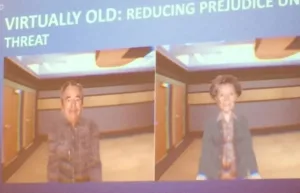Quick Search: Research is a series dedicated to unpacking some of the emerging research on 3D, VR, and other dynamic visualization technologies. See my introductory discussion on this topic, entitled the Research Chase. In the second article of this current series, I am hoping to unpack some insightful research on the educational role of virtual reality in promoting empathy and prosocial behaviors.
(See the previous article for more context: Quick Search: VR and Educational Research.)

“What if we could teach people about social issues so that they could not only learn facts, but they could also learn how to be more empathetic, to see things from another person’s point view?” asks Fernanda Herrera, a Stanford University PhD candidate, who recently presented at SXSWedu in Austin. She wonders if it is at all possible to employ virtual reality (crediting Chris Milk’s TED talk) as an “ultimate empathy machine”.
Citing some previous work at Stanford, Herrera described two interesting empathy-based studies:
Becoming the Superhero. In one virtual reality study, participants took on the role of a flying superhero who finds their city in a state of emergency. In the rush to evacuate the city, one child has inadvertently been left behind. Half of the study’s participants flew in to rescue the child in a helicopter, while half flew in as a full-fledged superhero. The research showed that participants who ‘became’ the superhero helped find the child faster and helped more thoroughly than those who flew in with a helicopter. Apparently, role models can be effectively ‘embodied’ in a VR experience.
Becoming a superhero in VR: Rescuing a child left behind.
An older version of me. In another study, the participants simply ‘inhabited’ an older avatar of themselves. Researchers were hoping to discover if the participants would become less prejudiced toward the elderly. One study was conducted using the medium of VR, while another experiment asked participants to simply ‘imagine’ themselves to be older. The results? Those participants who just imagined being elderly didn’t at all feel ‘connected’ to the elderly. But those who ‘embodied’ the age study group through VR felt more connected and also wanted to help.
Virtually Old: An instant aging machine for teaching empathy.
There are not many actual studies in empathy using VR, according to Herrera, who also cited related research from the field of psychology: “If we imagine being a part of a group, we become more empathetic to that person, but also to that entire group and more empathy leads to an altruistic motivation to help.” She asserts that “VR is good for perspective taking: we can have any experience from any point of view,” since VR works by replacing perceptual input from the real world with perceptual input from the virtual world. She adds: “We can take on different skin tone, become shorter or taller, and we can achieve body transfer and body schema.”
She explained: “We start having body cognition, adopting these virtual characteristics into our own. We start thinking of a ‘new self.’” Instead of just being told what someone’s life is like, what their struggles are like, “now we can struggle with them.” Yet a follow-up study, set up with the similar conditions to the studies above, evidenced no difference if participants felt their group was under threat. Evidently, the presence of competition within a VR learning encironment may in fact reduce the ability to empathize.
The problems with these studies were typical to the challenges faced in other studies: small sample sizes and/or required college student participation in the studies may have skewed the results. Still, the crowds paying attention to Fernanda Herrera at SXSWedu were undeniable. I hate to end with a teaser, but please come back for part 3 of this series, as I tackle some groundbreaking new research just coming out of Stanford University, research now being conducted by the delightful Fernanda Herrera. – Len Scrogan


